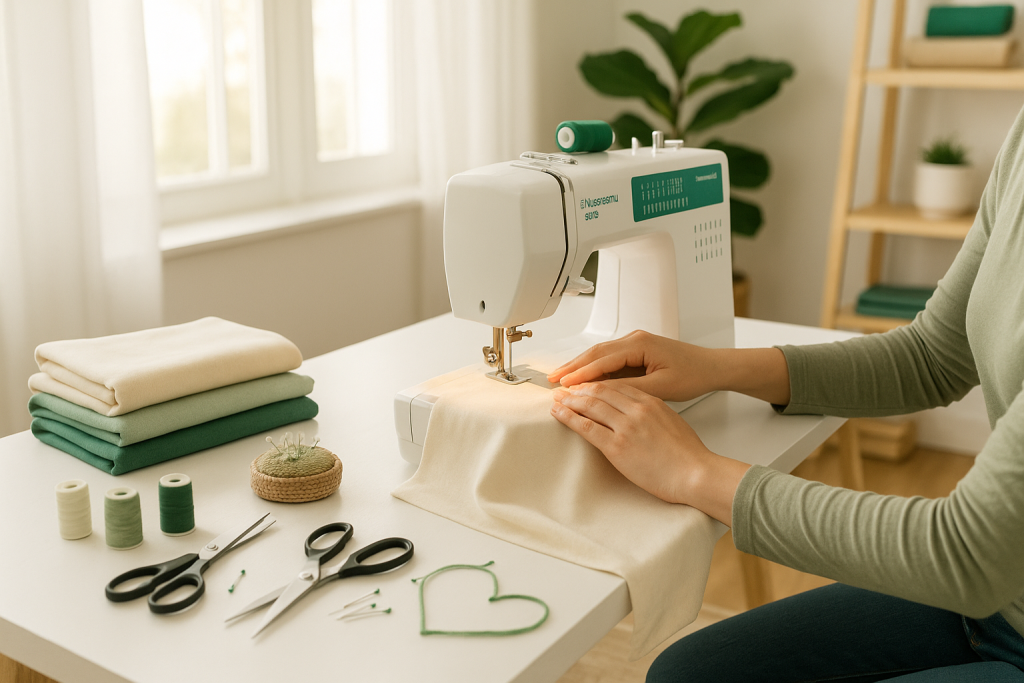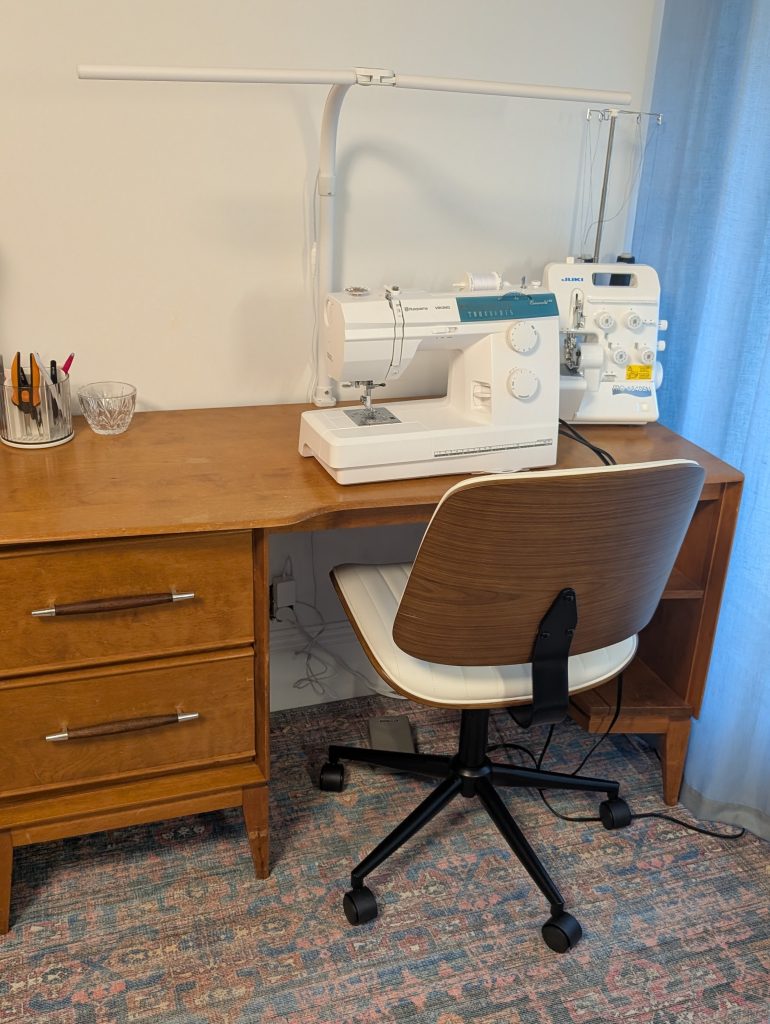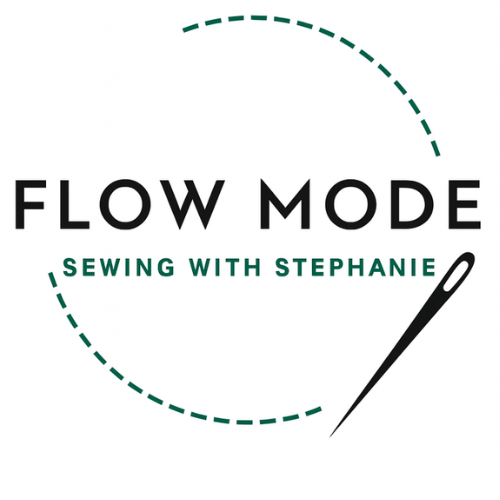
I still remember the feeling of choosing my first sewing machine. I grew up sewing on my grandma’s vintage Singer until it burnt out – something I now understand was caused by poor maintenance. In my early 20s I was gifted a low cost Singer that works just fine but had quirks. Once I started improving my sewing skills, I realized this low cost machine was actually taking away the joy of sewing because I was fighting the machine to do what it should do well. I decided it was time I buy a quality machine. But what I thought would be a fun process quickly became overwhelming. How many options were there? How was I supposed to know what I needed, when I was just starting out?
The students in the sewing class attended often haf the same experience. They walk into their first class with a brand-new machine, only to apologize that they bought the first one they saw. With so many options and so little guidance, it’s easy to get lost.
This guide is my effort to make shopping for a sewing machine easier! I’ll give you a few key questions to clarify your purchase, followed by a simple list of must-have features to cut through the noise and help you make a smart investment. I won’t tell you which machine to get because they are constantly changing and your needs are unique to you.
Key Questions to Clarify Your Purchase
Shopping for a machine can be an intimidating process, but showing up with a clear list of needs and limits will allow you to get to the root of the issue fastest.
- What is your budget? Sewing machines can cost anywhere from $50 to $15,000. Setting a practical budget before you shop is the best way to narrow down your options. A cheap, unreliable machine can convince you that you’re the problem, when it was really the machine all along.
- What do you want to sew? Are you looking to sew occasional holiday gifts and children’s clothing, or do you plan to sew heavier materials like denim and canvas? Many machines can handle a wide range of fabrics, but some are only built for lightweight sewing. Knowing what you want to make will help you choose a machine with a motor strong enough for your projects.
- What features do you actually need (versus what would be fun)? It’s easy to get derailed by a machine with dozens of novelty stitches, but in truth, you’ll use your straight stitch, zigzag, and buttonhole stitches about 98% of the time. Don’t let a long list of features convince you to buy a lower-quality machine with a weaker motor.
Practical Considerations for Your Workflow
Finding the right machine is also about fitting it into your life. Here are a few things to think about before you commit.
- Where do you plan to sew? If setting up your machine is a burden, you simply won’t do it. Consider the weight and size of the machine you’re looking at. If you need to pack it up and move it every time you sew, a very heavy or large machine (like a sewing machine/embroidery machine combo) can be cumbersome and discouraging. You could even hurt yourself or drop and break the machine.
- Are you “sewing curious?” If you aren’t ready to invest in a machine just yet, consider taking an in-person sewing class that has machines available for you to use. This will give you an idea of what features are important to you. You can talk to other students about what they are using and why they like certain features. Your sewing instructor will also have a ready log of machines they recommend and their unique reasoning for each.
Digital vs. Mechanical Machines
As you shop, you’ll see machines fall into two main categories:
- Mechanical Machines: These are the traditional, manual machines.. They have knobs and dials to adjust stitch length and width. They tend to be more durable because they have fewer moving electronic parts, and they are generally easier to troubleshoot. The downside is they offer fewer stitch options and features. Maintenance is typically simple, often just requiring you to clean the lint and oil the moving parts.
- Digital Machines: These machines have a computer screen and push-button controls. They often offer more features like a one-step buttonhole, memory for stitch patterns, and a needle-up/down function. They can feel more intuitive, but they are also more complex, which means more can go wrong. When they do need servicing, it often requires a professional technician.
My Personal Experience with Singer
The words Singer and sewing are almost synonymous. I’ve sewn on a handful of Singer machines, from vintage and heavy-duty models to modern and entry-level ones, and I’ve found the sewing experience wasn’t as fun as with other brands. In my experience, they tend to pull to the left, make uneven stitches, and buttonholes were a pain in the butt.
That being said, I learned to sew on Singers, and if you have one available to you, absolutely go with it if buying a machine isn’t in your budget or you are ‘sewing curious.’ It’s a great way to start. But my journey took a joyful turn when I moved onto my Viking Husqvarna Emerald 118 about eight months into my serious sewing journey. That experience really solidified for me that the machine you use can have a huge impact on your fun with this craft. Can you sew on a machine that isn’t perfect for you? Absolutely. But can machines with powerful motors that purr like a kitten bring a whole other level of joy and relaxation to your craft? Absolutely.
The Minimum for a Machine You’ll Love
To ensure your machine will last and grow with you, there are some non-negotiable features to look for. Beyond these basics, seek a machine with the best motor you can afford, one that can handle a range of fabric weights.
- Adjustable Stitch Length and Width: This is the core of all your sewing. You should be able to adjust both the length and width of your stitches independently.
- Buttonhole Function and Foot: Next to your basic straight and zigzag stitches, your buttonhole function is what you’ll use most. A machine that does not have this feature will not be able to grow with you if you plan to sew garments.
- Adjustable Needle Position: This allows you to sew better zippers and piping, providing the greatest flexibility for a wide range of projects.
- Integrated Free Arm: This is a part of the machine usually tucked inside a removable table or drawer. It’s smaller in circumference, making it simpler to sew cuffs, collars, and other small-scale projects.
- Needle Down Function: This is a button that sets the needle to always end down, in the throat plate of the machine, which is incredibly useful when pivoting at corners and for topstitching.
Ultimately, I can’t tell you what makes the most sense for you. You need to consider what you have available to you. Are you “sewing curious” or “sewing obsessed?” Do you have access to in-person classes with machines to try out? Once you have your answers to these questions and a machine with these non-negotiable features, you’re ready to get started. The right machine is the first step to unlocking your creative flow and building a wardrobe you’ll be proud to wear.

